Introducing EverQuest Next
Scott Hawkes takes us through SOE's incredible new MMO
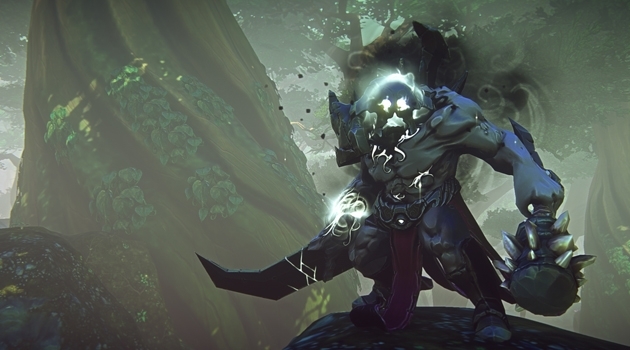
Grail 3: A Life of Consequence
It’s been a complaint aimed at MMOs for a long time: I can’t really change the world I play in. There are some exceptions to the rule—such as EVE Online—but it’s generally true that if you clear a pack of mobs, you can soon swing by and see the identical pack standing happily where you had just been.
EverQuest Next is attempting to change that concept through the use of more emergent and dynamic AI.
Instead of a static spawn point of Orcs—such as the millions killed in the same spots in the original Crushbone—the NPCs in EQ Next have a bit more independence. The orcs are spawned into the world and they find the kind of environment that appeals to them, which might lead to them congregating in similarly isolated areas that would be dangerous for unaware passers-by.
Though this seems a negligible difference, the use of self determining AI for the characters means that they can change their location due to their interaction with the player and the world.
If you were living in a place where you were being attacked on a daily basis, what would you do? I hope the answer is that you would move to somewhere else, which is exactly what the orcs of EverQuest Next will do.
Inform the guards of a local town of orc ambushes and they might start patrolling that area. Not wanting to tangle with the burly law enforcement, the orcs decide to relocate and find a new area to live in.
In other words, the days of spawn camping seem to be at an end.
Another example given was that the Combine Accord might ask you to go clear some enemy infestations from a forest. In any other MMO you would see the same mobs there within minutes of slaying them. In EQ Next, those same mobs figure “Forget this, these trees aren’t that great to put up with being killed on a regular basis” so they move off.
Your actions really do have an effect on the world around you, NPCs react to you in ways that finally make sense in a world that’s suppose to be immersive.
The AI works on a more granular level too; the enemies will even adapt to your combat style. Keep bashing the same attacks and you will be predictable and the NPCs will begin to counter you—making weapon switching highly important in order to keep them on their toes.
NPCs will react different to you socially; an example given was that if you help orcs kill humans, the local humans will start responding to you negatively.
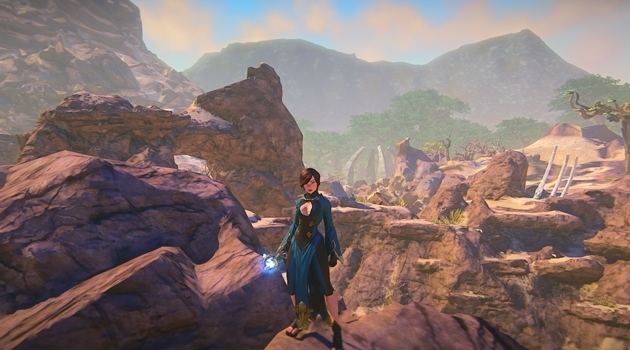
Though this all sounds wonderful, the most mind-blowing example of changing the world is through its physical structure.
Our plucky kerran and human were up against an ominously large earth elemental which unleashed a barrage of flashy attacks. One of them left a crater in the ground. I looked for where the player characters would be standing, but they weren’t there.
They had fallen through the earth.
EQ Next’s Norrath is much more than it first appears. Not only can you travel across and over it, you can also travel through it.
The elemental’s ability had hit a thin spot in Norrath’s crust, revealing a subterranean cavern which could have held more mobs, more quests, more adventure.
The world is multi-tiered and based on a timeline stretching from the ancient Keldan to the current Combine Era. With each epoch comes a buried area for you to unearth, with its own distinct environment and challenges.
They are procedurally generated, meaning that, for example, if the devs set off an earthquake it could collapse one of the caverns, which would be automatically created elsewhere below Norrath’s surface.
Players will have abilities allowing them to phase through the ground—or just grab a shove and dig—to find these hidden areas. The potential for exploration is absolutely massive and it can happen on the fly as an unexpected, dangerous and exciting by-product of exerting the great powers you can wield in combat.
Imagine getting into a standard fight with a local creature and accidentally destroying a weak spot in the ground. Suddenly, you find yourself in a completely new area below, with new mobs that aren’t happy about the unexpected visitor in their midst.
Doesn’t that sound pretty bloody great?
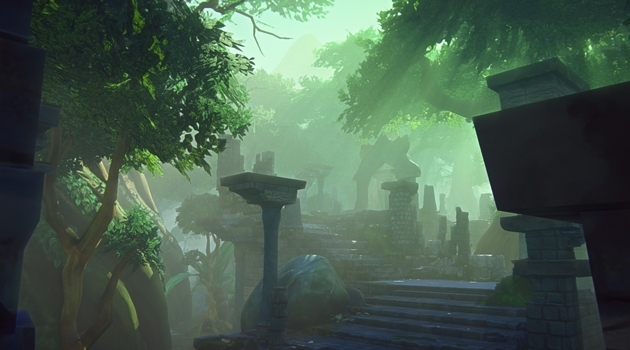
Grail 4. Permanent Change
So even if you do see some change in your MMO, it rarely feels like you had a great hand in it or that it will last for very long. Dave and the rest of the team want to make that kind of experience a remnant of the past.
Rallying Calls are like public events but more. Much more.
Lasting for months, Rallying Calls, when initiated, automatically flag every player in the world and allow them to contribute.
The example that Georgeson fleshed out was the overarching task to build a city called Halas. At first players would just set up tents in the area while they found resources to build better structures.
This could lead to them interacting with NPCs and, due to the dynamic AI, lay out in ever expanding ways. Imagine the local Goblin King being displeased with the new interlopers on his lands. He decides to send in raiding parties to wipe out the annoyance.
Players with a crafting mindset could help build new defenses to fend off the attacks while the more muscular adventurers try to rout the goblins.
As the fledgling Halas’ defenses improve and the strength of force of the townspeople increases, the Goblin King decides he can’t handle the situation alone, so forms alliance with other NPC races to really bring the pain.
Under this new threat, the settlers dig into the ground, creating a quarry to hew stone for a more permanent defensible structure. Unfortunately, digging deep into Norrath unleashes strange creatures that attack indiscriminately, killing both players and enemy NPCs alike.
Breaking the siege of Halas would complete the victory scenario and end the Rallying Call. So would Halas soon go away, its lands cleared ready to set up the long term public quest once more?
No. Halas would stand, a new city for players to visit, one that they helped build themselves, a permanent mark left on the game.
The team would then start a new Rallying Call elsewhere; a new indelible change to the world begins to take shape.
I’m delighted with the concept, I think it’s something that makes a ton of sense and brings an interaction with an MMO world that’s been sorely lacking.
So that’s EQ Next then. Nothing more to see here.
Well, except for the other game.
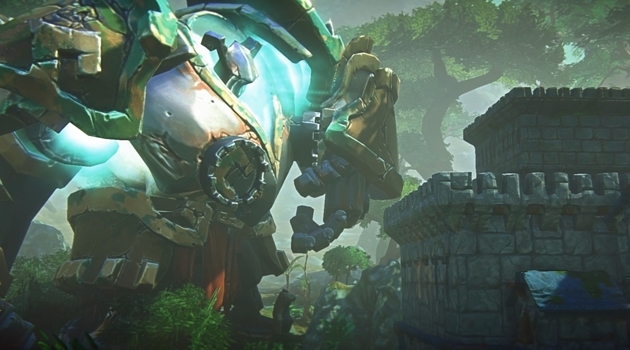
After watching a iron golem smash a building in a way no other MMO has the capability to show—the massive fist smashed debris apart in precisely the way it physically should, not in some pre-ordained approximation—the throng present at the presentation were told just how powerful the voxel tools the team has are.
They’re so powerful, the development team would spend time one-upping each other until the question was asked “What if we let the players do this?”
And so EverQuest Next Landmark was born.
A playground for creators, EverQuest Next Landmark is powered by all of the tools that are being used to develop EverQuest Next. A multitude of procedurally generated worlds are spun up for players to jump into and begin to build objects.
A player, through a character that resembles one from EverQuest Next, simply has to find a free spot of land and plant a flag in the ground, claiming the land. Then it’s up to the imagination of the individual to make best use of the tools at hand; which seemed to have an impressive scope of creation.
The voxel tool used to create blocks is resizable, meaning a very precise power to build. Added to this are a bevel and a smoothing option which can have quite startling effects, to sculpt pretty much any shape conceivable.
Obviously, Minecraft will immediately spring to mind, but the tools that players in EverQuest Next will wield have much more refinement available. A sphere was shown which had the appearance of a typical Minecraft object: a series of blocks in a step formation that forms the basis of an identifiable, but imperfect, sphere.
Then, with obvious contrast, an EverQuest Next Landmark version with its smoothing tool was revealed; the sphere was perfect in shape.
Enter the Player Studio; all objects built in the game can be bundled and sold. Not only will the object bring cash to the creator from the original conception, if it is incorporated into another player’s larger construction, it will generate further royalties.
The example used was of a tower, created by the first player, which is incorporated in a castle designed by the second. Each time the castle sells, both players receive cash.
There are some limitations. Of course, what you build must adhere to certain common sense restrictions—sorry, no giant genitalia allowed—and must befit the concept of Norrath.
Make something that is tremendous. That would look good even in the world of EverQuest Next and that could be the outcome: the best builds will be included in EverQuest Next at launch.
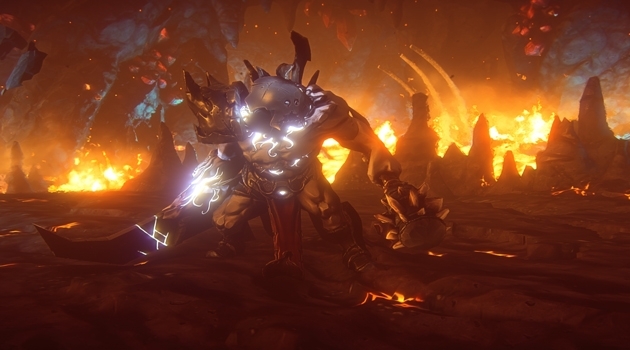
To end the presentation after more Steve Jobs “one more thing” endings than a Peter Jackson movie, John Smedley returned to introduce the evolution of PlanetSide 2’s Roadmap.
PS2 gives the community the chance to have a say in how things are developed for Auraxis, with voting determining priority and comments giving feedback to developer choices.
This has been the testing ground for EverQuest Next and EverQuest Next Landmark’s approach to hivemind design.
Roundtable, which will launch immediately, promises to make the two games the most openly developed in MMO history.
“We will show everything” but the overly complex nitty gritty Smedley promised, with the community being brought in to discuss everything with the developers.
The concept of “It’s our world now” sums up an intended, involved partnership between the developers and the fans of the games. SOE hopes the result will be something that has never been seen before, from conception, to development to realization.
And that was that.
Frankly, I was a little stunned by the events that transpired today.
This wasn’t what I expected, which, as a slightly jaded MMO gamer, is a simply marvelous feeling. For as many surprises and treats that were garnered a dozen questions spring to mind.
I still have no idea about the “heart” of the game. What kind of MMO will this be? Are these incredible tools, an amazing environment and incredible options there to add depth to the kind of theme park MMO that players might be used to?
Or are there sandbox crafting systems and PvP—not mentioned once—waiting to just explode all of these fascinating developments into something mind-bogglingly expansive?
Those questions will be answered very shortly. I’ll be pestering the developers like a rabid dog for the rest of this week here in Las Vegas to get more answers. But, everyone will be able to find out very soon as SOE promises that we will be hearing a lot from them through an open dialogue with the gaming community at large as development moves forward.
Take a look around. Consider what MMOs mean to you.
If SOE delivers, today could be when the game truly changed.
Scott “Jarimor” Hawkes, Editor in Chief
Follow me on Twitter @Jarimor

 Aside from the cartoonish looking characters, I like most of the rest of the concepts:
Aside from the cartoonish looking characters, I like most of the rest of the concepts: 


